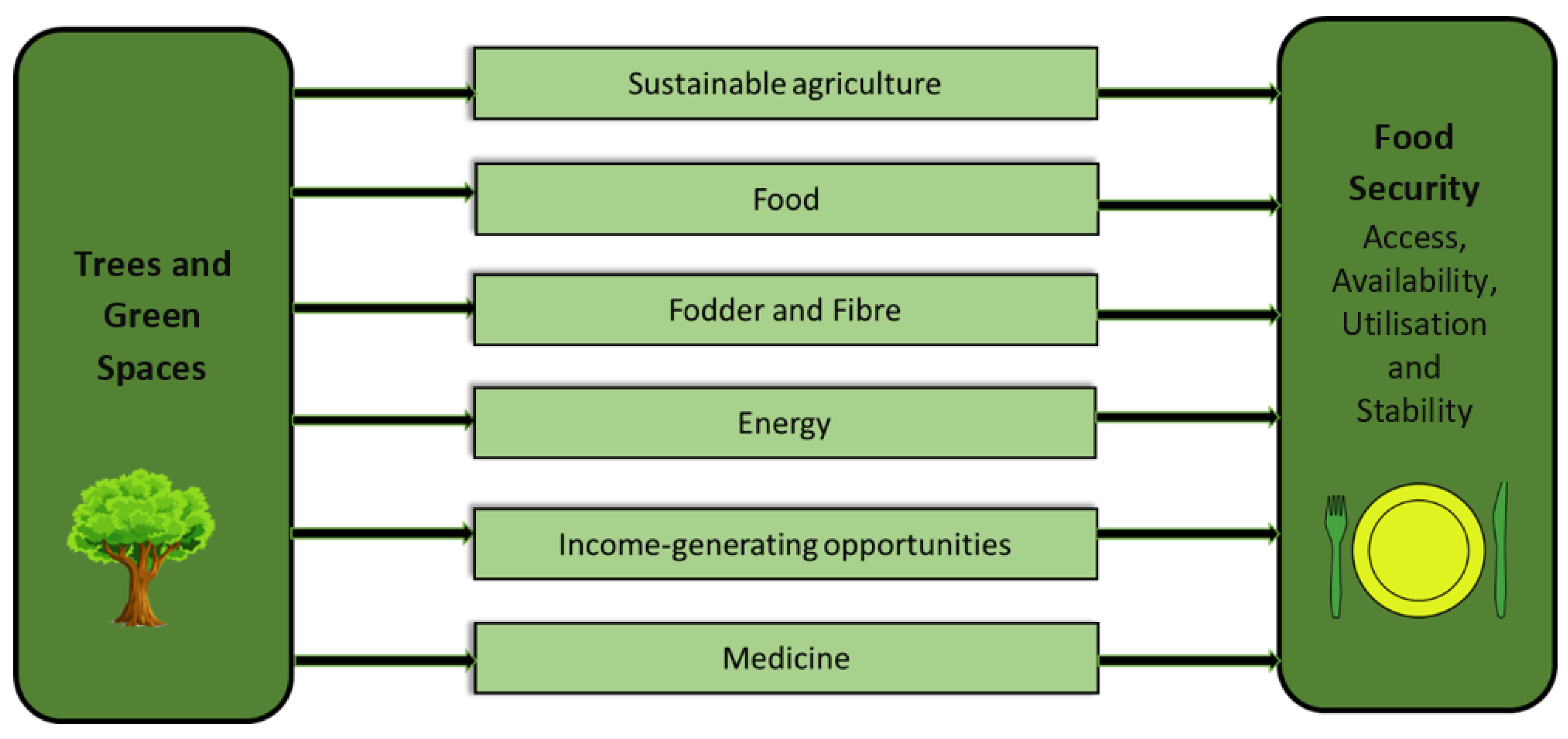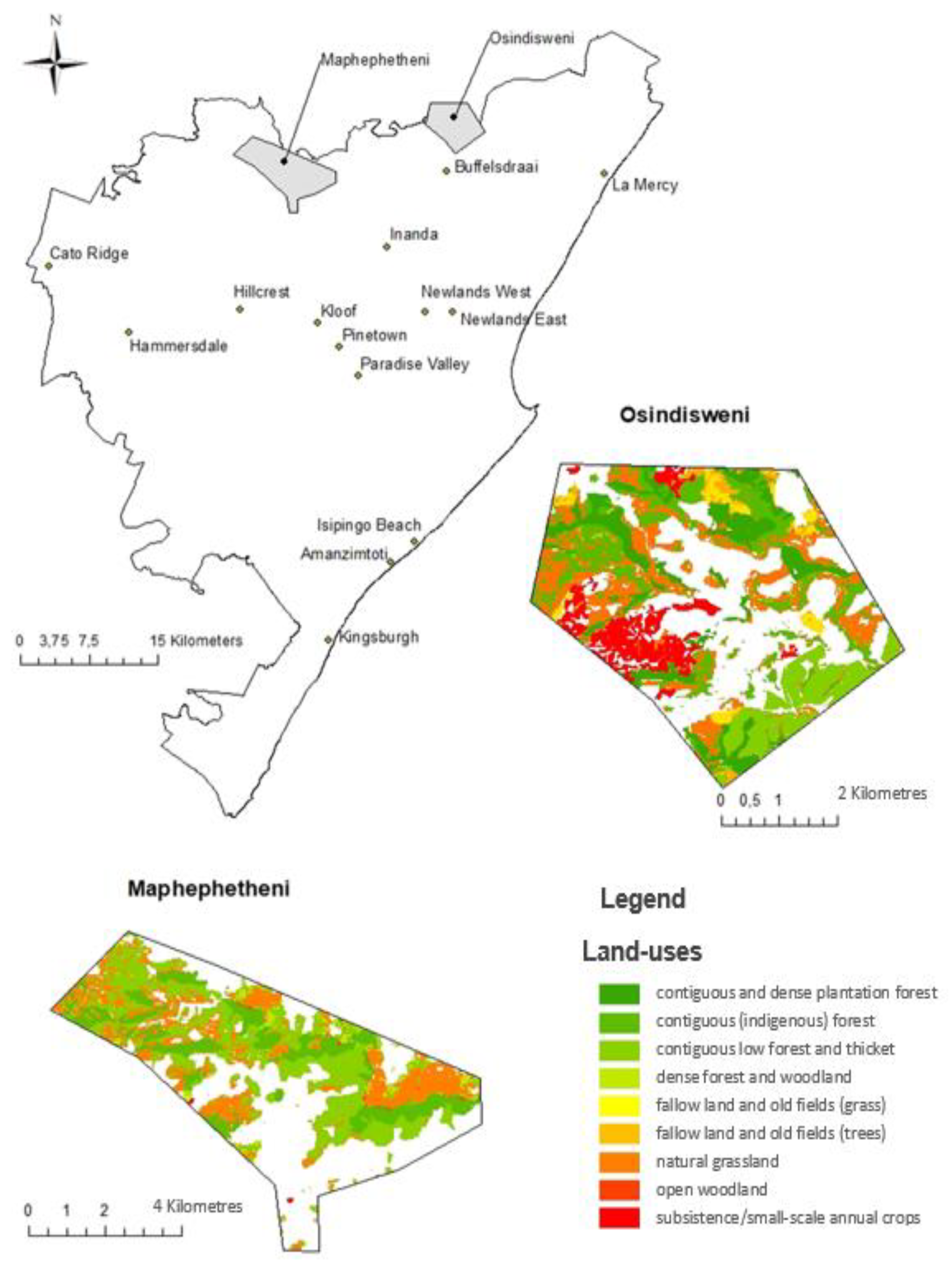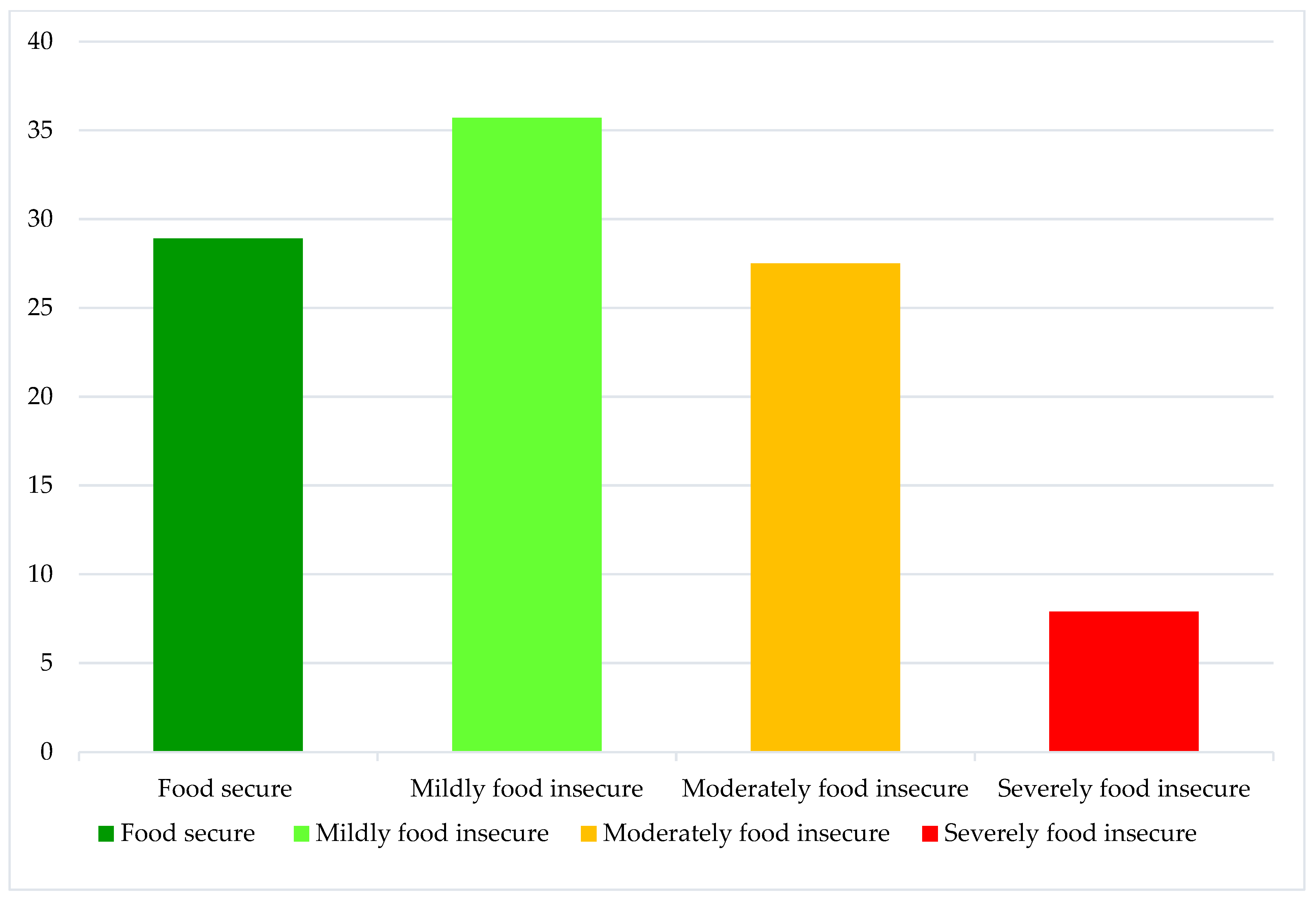The Contribution of Trees and Green Spaces to Household Food Security in eThekwini Metro, KwaZulu-Natal
Abstract
1. Introduction
2. Methodology
2.1. The Study Setting
2.2. The Selection of Respondents
2.3. Research Design
2.4. Data Analysis
2.4.1. Computing the HFIAS
2.4.2. The HFIAS Survey Questions
2.4.3. The Instrumental Variable Poisson Model
3. Results
3.1. Socio-Demographic Profiles of the Respondents
3.2. Household Food Insecurity Prevalence
3.3. The Instrumental Variable Poisson Model
4. Discussion
5. Conclusions and Recommendations
6. Limitations
Author Contributions
Funding
Institutional Review Board Statement
Informed Consent Statement
Data Availability Statement
Acknowledgments
Conflicts of Interest
References
- Stats, S. General Household Survey 2017 (Statistical Release P0318); Stats SA: Pretoria, South Africa, 2018.
- Pereira, L.M.; Kushitor, S.B.; Cramer, C.; Drimie, S.; Isaacs, M.; Malgas, R.; Phiri, E.; Tembo, C.; Willis, J. Leveraging the potential of wild food for healthy, sustainable, and equitable local food systems: Learning from a transformation lab in the Western Cape region. Sustain. Sci. 2022, 23, 1–20. [Google Scholar] [CrossRef]
- Greenberg, S. Corporate power in the agro-food system and the consumer food environment in South Africa. J. Peasant. Stud. 2017, 44, 467–496. [Google Scholar] [CrossRef]
- Hebinck, A.; Vervoort, J.M.; Hebinck, P.; Rutting, L.; Galli, F. Imagining transformative futures: Participatory foresight for food systems change. Ecol. Soc. 2018, 23, 1–7. [Google Scholar] [CrossRef]
- Drimie, S.; Hamann, R.; Manderson, A.P.; Mlondobozi, N. Creating transformative spaces for dialogue and action. Ecol. Soc. 2018, 23, 3–4. [Google Scholar] [CrossRef]
- Mkhize, M.; Sibanda, M. Food Insecurity in the Informal Settlements of Inanda Households Living with Children under 60 Months in Ethekwini Municipality. Children 2022, 9, 1521. [Google Scholar] [CrossRef] [PubMed]
- Lake, L.; Shung-King, M.; Hendricks, M.; Heywood, M.; Nannan, N.; Laubscher, R.; Bradshaw, D.; Mathews, C.; Goga, A.; Ramraj, T.; et al. Prioritising child and adolescent health: A human rights imperative. Child Adolesc. Health 2019, 3, 32. [Google Scholar]
- Greenberg, S. Agrarian reform and South Africa’s agro-food system. J. Peasant. Stud. 2015, 42, 957–979. [Google Scholar] [CrossRef]
- May, J. Food Security and Nutrition: Impure, Complex and Wicked; Centre of Excellence in Food Security: Cape Town, South Africa, 2017. [Google Scholar]
- Akinola, R.; Pereira, L.M.; Mabhaudhi, T.; De Bruin, F.-M.; Rusch, L. A review of indigenous food crops in Africa and the implications for more sustainable and healthy food systems. Sustainability 2020, 12, 3493. [Google Scholar] [CrossRef] [PubMed]
- Ramukhwatho, F.; duPlessis, R.; Oelofse, S. Preliminary drivers associated with household food waste generation in South Africa. Appl. Environ. Educ. Commun. 2018, 17, 254–265. [Google Scholar] [CrossRef]
- Chakona, G.; Shackleton, C.M. Food insecurity in South Africa: To what extent can social grants and consumption of wild foods eradicate hunger? World Dev. Perspect. 2019, 13, 87–94. [Google Scholar] [CrossRef]
- HLPE Report. Sustainable Forestry for Food Security and Nutrition; High Level Panel of Experts, Committee on World Food Security. 2017. Available online: https://www.fao.org/3/mt610e/mt610e.pdf (accessed on 10 November 2022).
- Pawlak, K.; Kołodziejczak, M. The role of agriculture in ensuring food security in developing countries: Considerations in the context of the problem of sustainable food production. Sustainability 2020, 12, 5488. [Google Scholar] [CrossRef]
- Milovanovic, V.; Smutka, L.; Jusufi, G. Cooperative farming potential for establishing food security within rural bangladesh. Acta Univ. Agric. Silvicult. Mendel. Brun 2016, 64, 2067–2074. [Google Scholar] [CrossRef]
- Sardeshpande, M.; Shackleton, C. Urban foraging: Land management policy, perspectives, and potential. PLoS ONE 2020, 15, e0230693. [Google Scholar] [CrossRef] [PubMed]
- De Jong, N. Addressing Social Issues in Rural Communities by Planning for Lively Places and Green Spaces. 2014. Available online: http://repository.nwu.ac.za/handle/10394/11014 (accessed on 10 November 2022).
- Turner-Skoff, J.B.; Cavender, N. The benefits of trees for livable and sustainable communities. Plants People Planet 2019, 1, 323–335. [Google Scholar] [CrossRef]
- Boatemma, S.; Drimie, S.; Pereira, L. Addressing food and nutrition security in South Africa: A review of policy responses since 2002. Afr. J. Agric. Resour. Econ. 2018, 13, 264–279. [Google Scholar]
- Munien, S.; Nkambule, S.S.; Buthelezi, H.Z. Conceptualisation and use of green spaces in peri-urban communities: Experiences from Inanda, KwaZulu-Natal, South Africa. Afr. J. Phys. Health Educ. Recreat. Danc. 2015. [Google Scholar]
- Sivadas, D. Pathways for Sustainable Economic Benefits and Green Economies in Light of the State of World Forests 2022; Springer: Berlin/Heidelberg, Germany, 2022. [Google Scholar]
- Poppy, G.M.; Chiotha, S.; Eigenbrod, F.; Harvey, C.A.; Honzák, M.; Hudson, M.D.; Jarvis, A.; Madise, N.J.; Schreckenberg, K.; Shackleton, C.M.; et al. Food security in a perfect storm: Using the ecosystem services framework to increase understanding. Philos. Trans. R. Soc. B Biol. Sci. 2014, 369, 20120288. [Google Scholar] [CrossRef] [PubMed]
- West, P.C.; Gerber, J.S.; Engstrom, P.M.; Mueller, N.D.; Brauman, K.A.; Carlson, K.M.; Cassidy, E.S.; Johnston, M.; MacDonald, G.K.; Ray, D.K.; et al. Leverage points for improving global food security and the environment. Science 2014, 345, 325–328. [Google Scholar] [CrossRef]
- Wittman, H.; Chappell, M.J.; Abson, D.J.; Kerr, R.B.; Blesh, J.; Hanspach, J.; Perfecto, I.; Fischer, J. A social–ecological perspective on harmonizing food security and biodiversity conservation. Reg. Environ. Chang. 2017, 17, 1291–1301. [Google Scholar] [CrossRef]
- Chihambakwe, M.; Mafongoya, P.; Jiri, O. Urban and peri-urban agriculture as a pathway to food security: A review mapping the use of food sovereignty. Challenges 2018, 10, 6. [Google Scholar] [CrossRef]
- Gitz, V.; Pingault, N.; Meybeck, A.; Ickowitz, A.; McMullin, S.; Sunderland, T.; Vinceti, B.; Powell, B.; Termote, C.; Jamnadass, R.; et al. Contribution of forests and trees to food security and nutrition. FTA Brief 2021. [Google Scholar] [CrossRef]
- Hadebe, S.; Modi, A.; Mabhaudhi, T. Drought tolerance and water use of cereal crops: A focus on sorghum as a food security crop in sub-Saharan Africa. J. Agron. Crop Sci. 2017, 203, 177–191. [Google Scholar] [CrossRef]
- Nhamo, L.; Mabhaudhi, T.; Magombeyi, M. Improving water sustainability and food security through increased crop water productivity in Malawi. Water 2016, 8, 411. [Google Scholar] [CrossRef]
- Oldewage-Theron, W.; Egal, A.A. Is food insecurity a problem among the elderly in Sharpeville, South Africa? Food Secur. 2021, 13, 71–81. [Google Scholar] [CrossRef]
- Greater Capital. Social assessment of the Buffelsdraai Landfill Site Community Reforestation Project; Unpublished report Durban; Report prepared for the Wildlands Conservation Trust, eThekwini Municipality, South Africa. 2011. [Google Scholar]
- McLean, C.T.; Ground, L.E.; Boon, R.G.C.; Roberts, D.C.; Govender, N.; McInnes, A.; Botes, W.; Allan, D.; Ivins, J. Durban’s Systematic Conservation Assessment; EThekwini Municipality, Environmental Planning and Climate Protection Department EThekwini Municipality: Durban, South Africa, 2016.
- Scott-Shaw, C.; Escott, B. KwaZulu-Natal Provincial Pre-Transformation Vegetation Type Map–2011. Unpublished GIS Coverage [kznveg05v2_1_11_wll zip], Biodiversity Conservation Planning Division, Ezemvelo KZN Wildlife, Cascades, Pietermaritzburg. 2011. Available online: https://www.phelamanga.co.za/images/Current_Special_Projects_PDF/17_Appendix_D7_Babanango_Travelers_Camp_Watercourse_Assessment_NatureStamp_Final_Report.pdf (accessed on 11 November 2022).
- Buthelezi, H.Z.; Munien, S.; Nkambule, S.S. Opportunities and constraints for community-based conservation: The case of the KwaZulu-Natal Sandstone Sourveld grassland, South Africa. Bothalia-Afr. Biodivers. Conserv. 2016, 46, 1–8. [Google Scholar]
- Ward, M.R.; Rosenberg, E. Revealing mechanisms in a transdisciplinary community reforestation research Programme. Afr. Eval. J. 2020, 8, 9. [Google Scholar] [CrossRef]
- Moyo, I.; Cele, H.M.S. Protected areas and environmental conservation in KwaZulu-Natal, South Africa: On HEIs, livelihoods and sustainable development. Int. J. Sustain. High. Educ. 2021. [Google Scholar] [CrossRef]
- Cheteni, P.; Khamfula, Y.; Mah, G. Exploring food security and household dietary diversity in the Eastern Cape Province, South Africa. Sustainability 2020, 12, 1851. [Google Scholar] [CrossRef]
- Coates, J.; Swindale, A.; Bilinsky, P. Household Food Insecurity Access Scale (HFIAS) for Measurement of Food Access: Indicator Guide, 3rd ed.; Food and Nutrition Technical Assistance Project: Washington, DC, USA, 2007. [Google Scholar]
- Gebreyesus, S.H.; Lunde, T.; Mariam, D.H.; Woldehanna, T.; Lindtjørn, B. Is the adapted Household Food Insecurity Access Scale (HFIAS) developed internationally to measure food insecurity valid in urban and rural households of Ethiopia? BMC Nutr. 2015, 1, 1–10. [Google Scholar] [CrossRef]
- Ndlovu, P.; Thamaga-Chitja, J.; Ojo, T. Impact of value chain participation on household food insecurity among smallholder vegetable farmers in Swayimane KwaZulu-Natal. Sci. Afr. 2022, 16, e01168. [Google Scholar] [CrossRef]
- Angelsen, A.; Jagger, P.; Babigumira, R.; Belcher, B.; Hogarth, N.J.; Bauch, S.; Börner, J.; Smith-Hall, C.; Wunder, S. Environmental income and rural livelihoods: A global-comparative analysis. World Dev. 2014, 64, S12–S28. [Google Scholar] [CrossRef] [PubMed]
- Kamanga, P.; Vedeld, P.; Sjaastad, E. Forest incomes and rural livelihoods in Chiradzulu District, Malawi. Ecol. Econ. 2009, 68, 613–624. [Google Scholar] [CrossRef]
- Nichols, A. Causal inference with observational data. Stata J. 2007, 7, 507–541. [Google Scholar] [CrossRef]
- De Cock, N.; D’Haese, M.; Vink, N.; Van Rooyen, C.J.; Staelens, L.; Schönfeldt, H.C.; D’Haese, L. Food security in rural areas of Limpopo province, South Africa. Food Secur. 2013, 5, 269–282. [Google Scholar] [CrossRef]
- Kennedy, G.; Ballard, T.; Dop, M.C. Guidelines for Measuring Household and Individual Dietary Diversity; Food and Agriculture Organization of the United Nations: Rome, Italy, 2011. [Google Scholar]
- Taruvinga, A.; Muchenje, V.; Mushunje, A. Determinants of rural household dietary diversity: The case of Amatole and Nyandeni districts, South Africa. Int. J. Dev. Sustain. 2013, 2, 2233–2247. [Google Scholar]
- Maziya, M.; Mudhara, M.; Chitja, J. What factors determine household food security among smallholder farmers? Insights from Msinga, KwaZulu-Natal, South Africa. Agrekon 2017, 56, 40–52. [Google Scholar] [CrossRef]



| Did Your Household Face the Following Problems in the Past Four Weeks | Yes | Rarely | Sometimes | Often | ||||
|---|---|---|---|---|---|---|---|---|
| Freq. | % | Freq. | % | Freq | % | Freq. | % | |
| Worry that your household would not have enough food? | 175 | 62.5 | 87 | 31.1 | 72 | 25.7 | 16 | 5.7 |
| Unable to eat the kinds of foods you preferred because of a lack of resources? | 183 | 65.4 | 86 | 30.7 | 69 | 24.6 | 28 | 10 |
| Eat a limited variety of foods due to a lack of resources? | 170 | 60.7 | 81 | 28.9 | 73 | 26.1 | 18 | 6.4 |
| Eat some foods that you did not want to eat because of a lack of resources to obtain other types of food? | 170 | 60.7 | 81 | 28.9 | 73 | 26.1 | 18 | 6.4 |
| Eat a smaller meal than you felt you needed because there was not enough food? | 162 | 57.9 | 74 | 26.4 | 78 | 27.9 | 12 | 4.3 |
| Eat fewer meals in a day because there was not enough food? | 149 | 53.2 | 68 | 24.3 | 66 | 23.6 | 15 | 5.4 |
| Was there ever no food to eat of any kind in your household because of a lack of resources to get food? | 127 | 45.4 | 42 | 15 | 68 | 24.3 | 17 | 6.1 |
| Go to sleep hungry because there was not enough food? | 46 | 16.4 | 33 | 11.8 | 6 | 2.1 | 5 | 1.8 |
| Go a whole day and night without eating anything because there was not enough food? | 18 | 6.4 | 7 | 2.5 | 9 | 3.2 | 2 | 0.7 |
| Osindisweni | Maphephetheni | |
|---|---|---|
| Sex of the respondents | ||
| Male | 18.4% | 26.5% |
| Female | 81.6% | 73.5% |
| Household composition | ||
| Nuclear | 98.7% | 94.1% |
| Polygamous | 1.3% | 5.9% |
| Level of education | ||
| Primary | 14.5% | 20.6% |
| Secondary | 63.2% | 56.6% |
| Tertiary | 13.2% | 13.2% |
| No education | 9.2% | 9.3% |
| Marital status | ||
| Married | 65.8% | 57.4% |
| Single | 18.4% | 23% |
| Separated | 6.5% | 7.4% |
| Widowed | 9.2% | 12.3% |
| Source of regular meals | ||
| Trees and green spaces | 12% | 28.8% |
| Bought from markets | 64% | 51.7% |
| From friends and relatives | 24% | 19.5% |
| Farming and gardening | ||
| Communal gardens | 2% | 2.9% |
| Backyard gardens | 90.7% | 93% |
| Livestock | ||
| Cattle | 17.3% | 12.2% |
| Goats | 34.7% | 22.4% |
| Sheep | 1.3% | 1% |
| Poultry | 40% | 35.1% |
| Income | 30% | 23% |
| Friends and family | 72% | 41% |
| Social and government grants | - | 2% |
| Crafts, medicine, and fuel-wood sales | - | 2% |
| Livestock sales | - | 1% |
| Crop, fruit, and vegetable sales | 16% | 16% |
| Pension | 40% | 46% |
| Part-time employment | 15% | 17% |
| Full-time employment |
| HFIAS | Coef. | St.Err. | dy/dx | Std. | p-Value |
|---|---|---|---|---|---|
| Cultivated green spaces | −0.097 | 0.030 | −0.691 | 0.215 | 0.001 ** |
| Non-cultivated green spaces | 0.140 | 0.030 | 0.992 | 0.211 | 0.000 *** |
| Local trees | 0.059 | 0.014 | 0.422 | 0.101 | 0.000 *** |
| Wealth Index: Non-Agricultural Related Assets and Agricultural Related Assets | −0.146 | 0.022 | −1.041 | 0.159 | 0.000 *** |
| Gender of household head | −0.186 | 0.054 | −1.324 | 0.384 | 0.001 *** |
| Age of household head | 0.006 | 0.002 | 0.040 | 0.011 | 0.000 *** |
| Marital status of household head | 0.107 | 0.016 | 0.758 | 0.112 | 0.000 *** |
| Household size | 0.012 | 0.009 | 0.088 | 0.063 | 0.162 |
| Education level of the head of household | −0.072 | 0.027 | −0.512 | 0.190 | 0.007 *** |
| Number of dependents | 0.021 | 0.010 | 0.152 | 0.071 | 0.031 ** |
| Monthly Income | 0.000 | 0.000 | −0.001 | 0.000 | 0.000 *** |
| Grants | −0.315 | 0.116 | −2.239 | 0.825 | 0.007 *** |
| Access to training, agricultural assistance, extension, and advisory services | −0.057 | 0.101 | −0.404 | 0.721 | 0.575 |
| Constant | 2.164 | 0.135 | *** | ||
| Mean dependent var | 7.107 | ||||
| Pseudo r-squared | 0.114 | ||||
| Chi-square | 314.296 | ||||
| Akaike crit. (AIC) | 2476.966 | ||||
| Bayesian crit. (BIC) | 2527.853 | ||||
| Prob > chi2 | 0.000 |
Disclaimer/Publisher’s Note: The statements, opinions and data contained in all publications are solely those of the individual author(s) and contributor(s) and not of MDPI and/or the editor(s). MDPI and/or the editor(s) disclaim responsibility for any injury to people or property resulting from any ideas, methods, instructions or products referred to in the content. |
© 2023 by the authors. Licensee MDPI, Basel, Switzerland. This article is an open access article distributed under the terms and conditions of the Creative Commons Attribution (CC BY) license (https://creativecommons.org/licenses/by/4.0/).
Share and Cite
Bhebhe, Q.N.; Ngidi, M.S.C.; Siwela, M.; Ojo, T.O.; Hlatshwayo, S.I.; Mabhaudhi, T. The Contribution of Trees and Green Spaces to Household Food Security in eThekwini Metro, KwaZulu-Natal. Sustainability 2023, 15, 4855. https://doi.org/10.3390/su15064855
Bhebhe QN, Ngidi MSC, Siwela M, Ojo TO, Hlatshwayo SI, Mabhaudhi T. The Contribution of Trees and Green Spaces to Household Food Security in eThekwini Metro, KwaZulu-Natal. Sustainability. 2023; 15(6):4855. https://doi.org/10.3390/su15064855
Chicago/Turabian StyleBhebhe, Qhelile Ntombikayise, Mjabuliseni S. C. Ngidi, Muthulisi Siwela, Temitope O. Ojo, Simphiwe Innocentia Hlatshwayo, and Tafadzwanashe Mabhaudhi. 2023. "The Contribution of Trees and Green Spaces to Household Food Security in eThekwini Metro, KwaZulu-Natal" Sustainability 15, no. 6: 4855. https://doi.org/10.3390/su15064855
APA StyleBhebhe, Q. N., Ngidi, M. S. C., Siwela, M., Ojo, T. O., Hlatshwayo, S. I., & Mabhaudhi, T. (2023). The Contribution of Trees and Green Spaces to Household Food Security in eThekwini Metro, KwaZulu-Natal. Sustainability, 15(6), 4855. https://doi.org/10.3390/su15064855







